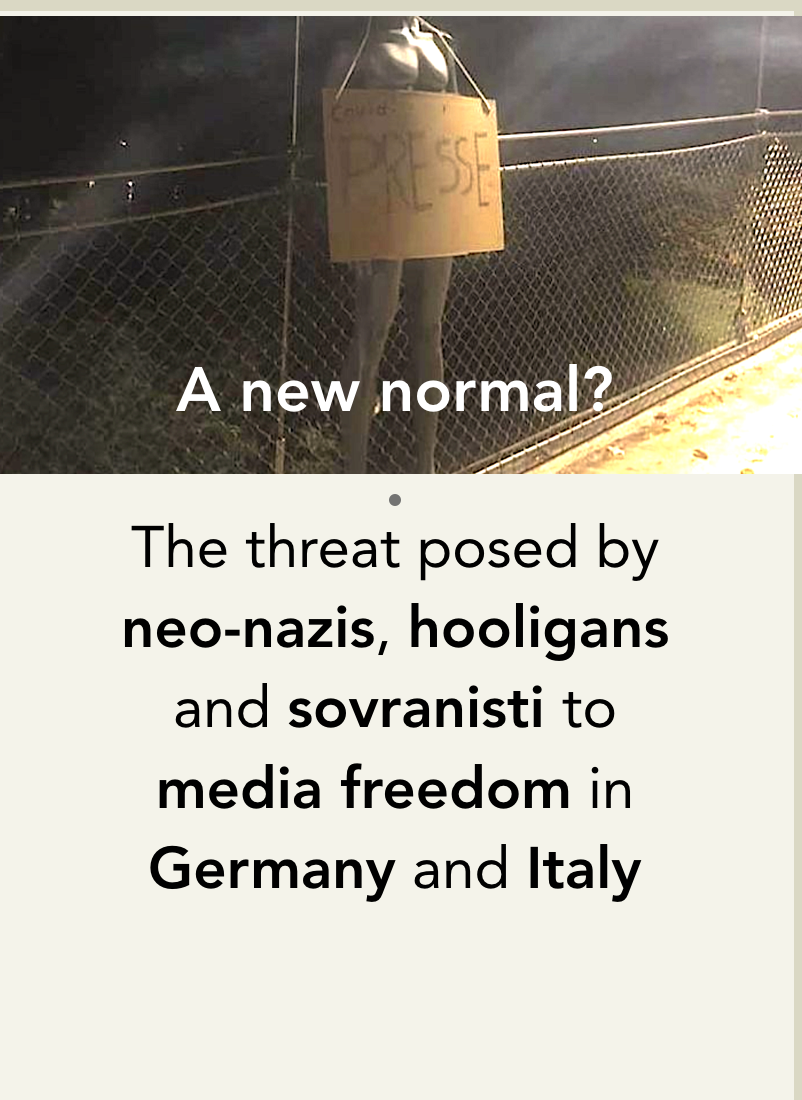The threat posed by neo-nazis, hooligans and sovranisti to media freedom
- RSF alerts for the risk of violence against journalists to become “the new normal”
- Despite all efforts, conspiracy theorists like David Icke continue to spread disinformation online
Aldo De Luca | MediaTalks, London
It sounds medieval, but the idea of killing the messenger who brings bad news is still alive in some European countries. The region is experiencing a wave of violence against media professionals in the wake of Covid-19’s second wave, which has triggered frustration at the return of restrictions to curb infection rate.
The word “killing” is not an exaggeration. The scenes of the attacks it Italy are impressive. Many were filmed by the victims themselves or by their crews.
According to RSF,the demonstrators and their leaders are yet to distance themselves from this violence. At times, the police appear helpless to intervene, sometimes even impeding the coverage of events, instead of firmly protecting the right to free reporting.
“If the neo-Nazis and hooligans have their way, the new normal in these times of coronavirus will include constant harassment, threats and attacks against journalists,” said Christian Mihr, managing director of Reporters Without Borders (RSF) Germany.
“Anyone who fails to clearly distance themselves from the violent right-wing scene during demonstrations accepts that the media can only report on certain topics at risk of life and limb. Police and security authorities must ensure effective protection for media representatives during demonstrations and enforce the basic right to freedom of the press,” he added.
The organisation states that latest events have underlined a trend that started months ago: journalists are routinely harassed, threatened or obstructed during protests against the government’s COVID-19 measures:
“In Berlin alone, DJU have recordedmore than 100 such incidents at COVID-19 related protests in the past six months. Around ten of these cases are said to involve media workers who were kicked or beaten. There have also been reports ofabuse and harassment of female photographers or camera teams, and evendeath threats against reporters.”
In Italy, media and health professionals under threat
In some countries, like Italy, hate extends to health professionals as well. Attacks are being held by the sovranisti (sovereigns), as Italian nationalists present themselves.
Counselling by doctors on how to protect against the virus has been prompting reaction from Covid-deniers, with messages criticising the so-called “usual terrorist propaganda”.
In Rimini, a raid against cars of health professionals left 70 vehicles destroyed. Doctors and nurses, praised as heroes in the first wave of the pandemic, turned into enemies of those who do not accept lockdown and deny the existence of the coronavirus.
The Media Freedom Rapid Response (MFRR) issued a statement on November 16th expressing concerns over the string of physical attacks, death threats and acts of intimidation against journalists and media workers covering anti-lockdown protests across Italy.
The organisation said that over the previous three weeks before the statement was issued, at least nine incidents involving 14 members of the Italian media in six different cities were documented, including one photojournalist being hospitalised with a head trauma following an attack:
“On several occasions, Italian newspapers and media freedom groups have reported that anti-media slogans or songs have been chanted by the crowds, which have included death threats and journalists being denounced as “terrorists”.
Our organisations welcome the swift condemnation of these attacks by the Italian officials and urge law enforcement authorities to thoroughly investigate all incidents to identify those responsible and hold them to account.”
The incidentes highlighted by RSF and MFRR in Italy and Germany
Palermo, Italy
On 28 October, according to reports, a journalist and a camera operator from Rai 2 news programme, TG2 were intimidated and robbed of their equipment by protesters as they were covering anti-curfew protests in the Sicilian city of Palermo.
Naples, Italy
On 23 October, Paolo Fratter, a reporter for Sky TG 24, and camera operators Vincenzo Triente and Fabio Giulianelli, were attacked and had glass bottles thrown at them as they covered protests in Naples. One man wearing a motorcycle helmet pushed the camera operator and another aggressively pinned Fratter to the bonnet of a car. Giulianelli was hit in the leg by a stone but neither journalist was seriously injured.
On 19 October, journalist Mimmo Rubio was forced to barricade himself inside his house after receiving threats from a crowd protesting COVID-19 measures in Naples. Video footage shows a group of around 20 people wearing helmets and driving scooters chanting and shouting insults. After the incident, Rubio was given police protection to ensure his safety and the prosecutor of the Republic of Naples initiated a case.
Rome, Italy
On 10 October, Saverio Tommasi, a journalist at Fanpage.it, was insulted and threatened by anti-face mask protesters as he was reporting from a demonstration. Tommasi was sworn at and targeted with death threats, with one man screaming at him: “You piece of shit, you’ll die shot”. At one point, the situation became so volatile that Tommasi was escorted away under police protection.
The first scenes show an unmasked protester demanding that the reporter remove his. He threatens to spit in the reporter’s face.
Then another protester says that the journalist will end up as Mussolini’s son-in-law, Galeazzo Ciano. Minister of Foreign Affairs of the father-in-law’s regime, Ciano was part of the Grand Council of Fascism, which forced the expulsion of Mussolini and his arrest. After fleeing to Germany and being arrested there, Ciano was deported at the request of the new Mussolini government, which ordered his death.
When the reporter asks if they intend to shoot him, another protester prevents the attacker from continuing to speak. In the end, after being insulted by a servant, infamous, sold, piece of sh * t and threatened to become a martyr, the reporter noted a protester threatening to cough on him. When the situation started to become more dangerous, police officers removed the two journalists from the scene.
Minden, Germany
A mannequin with a sign around its neck reading “Covid-Presse” was a threat to the newspaper “Mindener Tageblatt” The figure was hanging over a bridge railing, hung by the neck with a rope and wears an eye mask that says “blind”. After some hours the police removed it. The state security in Bielefeld opened an investigation.
Benjamin Piel, editor-in-chief of Minden Tageblatt newspaper in Minden, tweeted:
“When criticisms of journalists become fantasies of execution, they become abhorrent. It happened tonight in Minden – a mannequin hanging from a bridge over Weser. Horrible”.
Disinformation online and violence
The International Press Institute, which monitors threats to press freedom, has also recorded incidentes in Israel, Austria, Slovenia and Brazil in recent weeks.
It is concerning that despite all efforts and awareness on the risk of fake news around the coronavirus, it continues to spread across social media platforms and over the web.
British conspiracy theorist David Icke, banned from Facebook, YouTube and Twitter for falsely link the spread of the coronavirus to 5G technology, is an example.
His website shows up on the first page on a Google search. Visitors can read his articles and watch the videos removed from YouTube – which belongs to the same Google.
On Friday (November 27) the homepage highlighted a post on the false claim that Bill Gates wants a mass vaccination against the coronavirus so that he can inject people with microchips. A dangerous help to the anti-vaccine movement. The request “please share” shows that Icke trusts on people sharing over social networks.
The website reveals another sign of lack of control of disinformation over the internet: expelled from conventional platforms, he invites to follow him on Parler, the American social network that has become a paradise for extremists due to the absence of moderation.
It’s sad that, just when promising results of three vaccines against Covid-19 are announced, hate speech on the web can delay the end of the pandemic crisis. Studies like the one carried out by the London School of Tropical Medicine and Hygiene show that the disease will only be under control if more than 55% of the population in each country accepts to be immunised.
As if the existing challenges ahead of the media industry were not enough, journalism have now another one: to regain the confidence of part of the population contaminated by ideas of radicals, lunatics and of those who are profiting from coronavirus crisis.
Will we miss the times when threats to press freedom came only from authoritarian governments?








